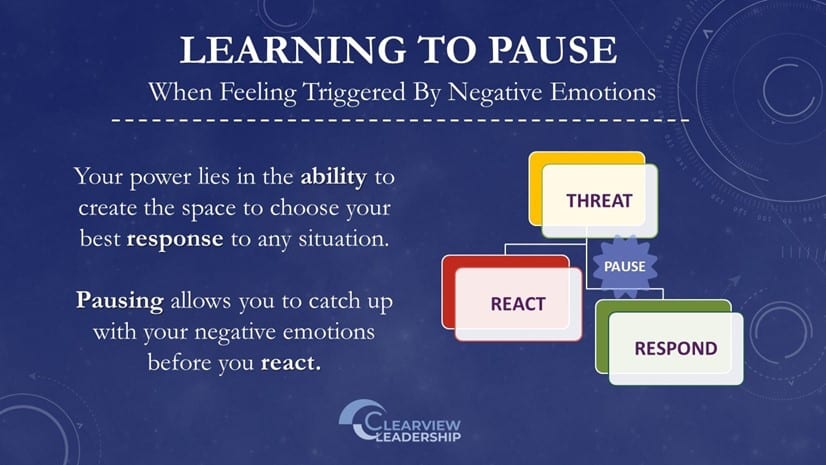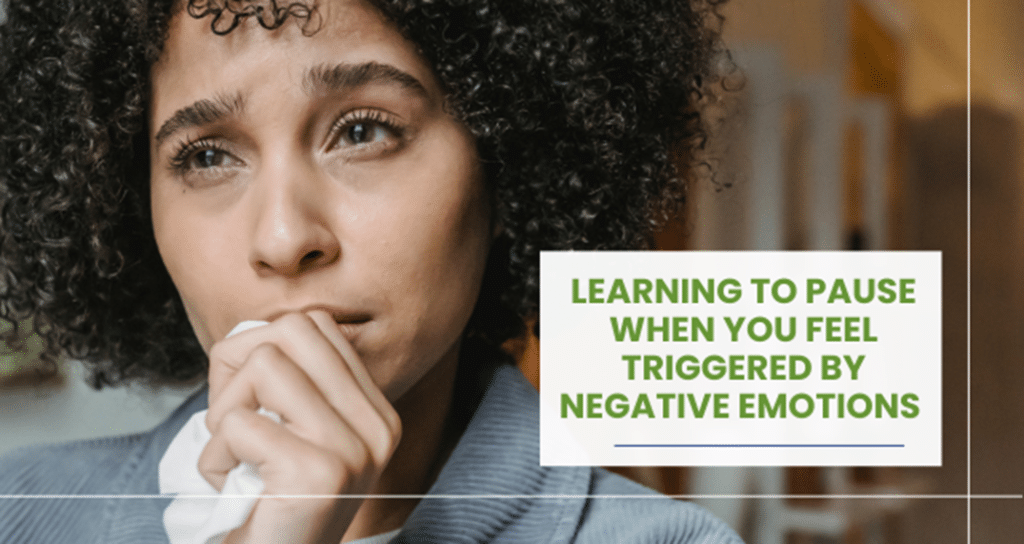
Our guest blogger is Tony Gambill, an established thought leader on Self-Leadership and Leading Others. He has published over 50 articles for Forbes Leadership on these topics and a book, Getting It Right When It Matters Most: Self-Leadership For Work & Life. Tony brings over 25 years of executive and leadership consulting experience in the for-profit and nonprofit sectors, technical fields, research, healthcare, government, and higher education.
How we respond during our most difficult moments will ultimately define our success. Emotionally competent people are aware of their feelings when experiencing fear, anger, loss, or frustration and choose actions that align with their core values. When we feel threatened and experience negative emotions, it can inhibit our ability to accurately perceive situations, solve problems, make decisions, and collaborate with others.
Learning to PAUSE helps you guard against negative emotions that distort how you perceive situations, make decisions, solve problems, and collaborate with others. The goal is to develop your ability to effectively manage your emotions so that they inform you but don’t define you.

𝟭) 𝗔𝘄𝗮𝗿𝗲𝗻𝗲𝘀𝘀 𝗢𝗳 𝗬𝗼𝘂𝗿 𝗣𝗵𝘆𝘀𝗶𝗰𝗮𝗹 𝗥𝗲𝘀𝗽𝗼𝗻𝘀𝗲𝘀 𝗧𝗼 𝗡𝗲𝗴𝗮𝘁𝗶𝘃𝗲 𝗘𝗺𝗼𝘁𝗶𝗼𝗻𝘀
One way to become aware of when your negative emotions are triggered is to understand how your body reacts when encountering a threatening situation. As physical signals are tangible, they tend to be easier to recognize than being aware of your emotional state. Some of the most common physical responses when experiencing negative emotions are:
- Clenched Jaw
- Shallow And Increased Breathing
- Rapid Heart Rate
- Sinking Feeling In Your Stomach
- Flushed Face
- Increased Sweating
𝟮) 𝗨𝗻𝗱𝗲𝗿𝘀𝘁𝗮𝗻𝗱𝗶𝗻𝗴 𝗬𝗼𝘂𝗿 𝗠𝗼𝘀𝘁 𝗦𝗲𝗻𝘀𝗶𝘁𝗶𝘃𝗲 𝗧𝗿𝗶𝗴𝗴𝗲𝗿𝘀
Understanding which conditions consistently cause you the most frustration, anger, or anxiety allows you to prepare strategies to respond effectively instead of constantly reacting. The Leadership Development Institute’s research found that the most common behavioral triggers for negative emotional responses in the workplace were perceiving others as:
- Unreliable
- Unappreciative
- Micro-Managing
- Abrasive
- Hostile
- Overly Analytical
- Aloof
- Self-centered
- Untrustworthy
𝟯) 𝗥𝗲𝗰𝗼𝗴𝗻𝗶𝘇𝗶𝗻𝗴 𝗬𝗼𝘂𝗿 𝗠𝗼𝘀𝘁 𝗖𝗼𝗺𝗺𝗼𝗻 𝗥𝗲𝗮𝗰𝘁𝗶𝗼𝗻𝘀 𝗪𝗵𝗲𝗻 𝗙𝗲𝗲𝗹𝗶𝗻𝗴 𝗧𝗿𝗶𝗴𝗴𝗲𝗿𝗲𝗱
Understanding your most common reactions when feeling triggered by negative emotions allows us to catch ourselves when we are reacting. It is important to stop ourselves from reacting to negative emotions because these behaviors rarely serve our longer-term goals and values. The ability to PAUSE and regain composure enables us to re-engage in the conversation and choose the responses that serve our best selves. Below are common reactions when feeling triggered by negative emotions:
- Arguing Or Debating
- Generalizing Based On One Incident
- Denying Other Perspectives
- Shutting Down
- Blaming Others
- Trying To Win At All Costs

The ability to Pause and regain composure enables us to re-engage and choose actions that serve our best long-term goals and values. The goal is to develop your ability to effectively manage your emotions so that they inform you but don’t define you. Psychologist and Holocaust survivor Viktor E. Frankl wrote, “Between stimulus and response there is a space. In that space is our power to choose our response. In our response lies our growth and our freedom.”
The ability to Pause allows you to access that freedom.
